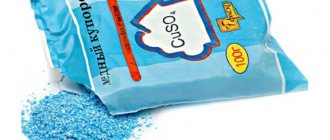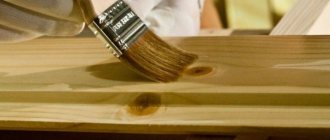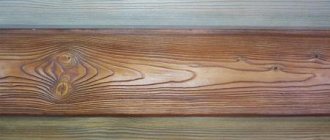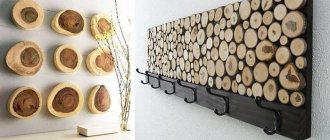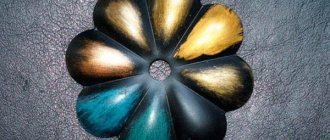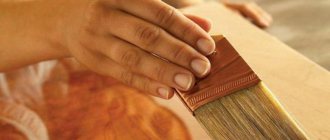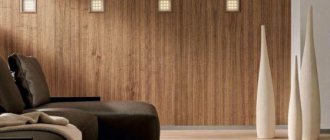Not everyone knows that stain is not just a liquid material, thanks to which wood acquires a brown tone and many of its shades.
Today, wood stains are rich in colors. In addition, it has antiseptic properties, which helps the wood last 2 times longer.
This article will help you get acquainted with modern stain. He will also answer questions about how to make wood stain with your own hands, what types of wood stain exist, and how to paint with wood stain correctly.
Return to content
Functions of stains
Finishes are used to process not only wooden surfaces, but also fiberboard, chipboard, MDF and plywood. Modern compositions, in addition to their main purpose, have disinfecting characteristics and prolong the life of wooden products. Solutions based on alkyds, oils and solvents avoid mold and repel harmful insects.
Sometimes stains are used to hide the real type of wood. Using stain, you can imitate an expensive type of wood (for example, oak) by painting ordinary pine with it. In addition, impregnation can accentuate the natural wood texture. If you use several stains correctly, you can combine a variety of shades into a single artistic design and turn a wooden product into a work of art.
What is the effect of ammonia staining?
Ammonia fumes affect the tannins in the wood, causing the material to change color to a darker one.
Advantages : Ammonia staining does not change the structure of the wood, but only darkens the main tone, leaving all the veins and grains visible. This is important when staining exotic woods or materials that have interesting textures, such as ash.
Disadvantages : Difficult to control the darkening process with ammonia haze. Different batches of wood or different parts of the same furniture can differ greatly from each other, despite using the same process and accurately selecting the percentage of ammonia.
The longer you treat oak wood with ammonia, the darker it becomes
In industrial production, it is not household ammonia that is used, but ammonium hydroxide (concentration from 26 to 30%). Such staining is carried out only in sealed chambers, and the masters in charge
The selected method is suitable for wood with a high content of tannins (tannins). The most popular wood species for using ammonia haze: oak, chestnut, ash. When treated with ammonium hydroxide vapor, this wood acquires a rich, luxurious color in shades from light coffee to black (depending on the exposure time).
The beautiful structure of apricot wood is better revealed after staining with ammonia and oil treatment, as in the third photo
Maple, hornbeam, birch, lilac, ash, hazel, and elm will not respond to treatment with ammonia vapors, or after prolonged exposure they will acquire an unattractive, dirty tint and become stained.
Designers and technologists are still trying to use ammonia haze for wood with a low tannin content. Through experiments, it turned out that if you saturate the surface of the workpiece with strong tea, let it dry, and then place it in a stain chamber or tank, the wood will still darken, but will not have such rich shades as oak or chestnut.
process, are required to wear gas masks, long gloves, and eye protection.
Staining process
Before staining, prepare a tightly sealed tank or staining chamber, depending on the size of the item you are going to paint.
You can make a staining chamber yourself. Assemble a frame from any wooden or plastic guides, wrap it with film. The main rule: the chamber is made as small as possible so that the concentration of ammonia vapor is maximum.
A wide bowl is placed at the bottom of the tank, and the wood to be painted is placed above it. Make sure that the edges of the parts do not come into contact with each other or with the walls of the tank; do not use metal supports. If you plan to use the wood not completely, then it can be leaned against the wall above the bowl, so the main part will be completely open to ammonia vapor, and the points of contact will then be cut off.
READ What is cypress?
Next, ammonium hydroxide is quickly poured into the bowl, and the container is tightly closed. The staining time with ammonia haze can range from 2 hours to a day. This period depends on the color you want to get. Once the process is complete, open the lid. Ready! You've got a classic stained wood.
Sometimes, due to humidity or a weak ammonia solution, the surface of the wood after staining is slightly deformed, and the top layer is partially lifted. In this case, you can simply sand the painted layer; do not be afraid to spoil the shade; with standard ammonia staining, the color changes over the entire surface of the product to a depth of 3–4 mm.
When staining, vapors penetrate deeply into the wood, so this method is also used for decorative beams or bars that will be sawed
Ammonia hydroxide is used in the household and sold without a prescription, but when using it you need to follow a few simple rules:
- Wear rubber gloves, safety glasses and a respirator. Do not expect that you will have time to quickly move away from the dishes in which the staining will take place without inhaling the fumes.
- Work only in a room with good ventilation or fully open windows; if it is possible to carry out the staining process outside, use it. You need to think through the weathering system before starting treatment, since the room will be filled with vapor in a few seconds.
- Use glass or plastic containers; ammonia can dissolve metal, especially aluminum.
- After finishing the staining process, the composition must be disposed of. The best way is to pour the used ammonia into a bucket of water and pour the resulting solution into a compost heap or onto beds under the roots of plants. You will receive free fertilizer.
Types of stains
The classification of stains is carried out according to the bases from which the solutions are made. Typically, stains are made using water, alcohol, oil, acrylic or wax. Below we will take a closer look at each of the listed basics.
Water based
Water-based stains are produced in two varieties:
- dry powder for mixing with water;
- ready-to-use aqueous solution.
The main disadvantage of water stains is the long drying period. Therefore, to obtain a uniform surface tone, it takes a lot of time.
When using aqueous compounds, the wood fiber rises. This emphasizes the structure of the material, but makes it less resistant to moisture. To avoid this effect, it is recommended to wet the surface of the wood before impregnation and then sand it well.
Alcohol base
Alcohol-based stains are solutions that include ethyl alcohol, organic dyes and pigments. Such compositions are used not only for decorative surface treatment, but also as antiseptics. As a result of treatment with alcohol solutions, pile raising is reduced and wood swelling does not occur.
Alcohol stains do not allow you to obtain uniformly painted surfaces, since such impregnations dry quickly, which leads to the formation of stains. Thus, alcohol solutions are more applicable to small objects, while for painting large surfaces this is not the best option.
Alcohol stains are applied exclusively using spray bottles. Painting with a brush is not recommended, since it is difficult to achieve high-quality impregnation in this case.
Oil base
Oil-based impregnations allow you to obtain a wide variety of shades. Similar stains are produced based on dyes that dissolve well in oils and drying oils. The solvent element is white spirit.
Working with oil sealant is easy: it can be applied either with a brush or from a sprayer. Such stains do not lift wood fibers and spread evenly over the surface.
Acrylic base
Acrylic-based stains are the latest word in the development of tinting compositions. Thanks to acrylic, a thin colored film appears on the surface. It performs not only decorative, but also protective functions, limiting excessive moisture of the material. Acrylic compounds dry quickly, have no unpleasant odors, are safe and can be used to process any type of wood.
When treating the surface with acrylic paint, you should not get carried away with a large number of layers. As a rule, a couple of layers are enough. If you overdo it, stains will remain on the wooden product.
Wax base
Just like acrylic stains, wax impregnations form decorative and protective films. Typically, such compositions are used together with surface polishing. Wax stain is applied using a soft cloth.
Note! Wax stains should not be used if you plan to treat wood with two-component acid-curing varnishes or polyurethane paints.
Selecting the desired shade
It is a well-known fact that wood stain, applied in several layers, determines the final color of the surface. In order to understand what it will be like, you need to make a color test.
For this purpose, the prepared scrap board is thoroughly polished. Then it is completely saturated with the first layer. After waiting for it to dry, apply a second layer, leaving a third of the board untreated. Cover the surface with the last layer, leaving two-thirds untouched this time.
Related article: Machine for the production of profiles for plasterboard: production of frame elements
And finally, a completely dry board is covered with two layers of varnish, not forgetting to dry each of them. After completing this procedure from start to finish, you can choose the tone you would like to achieve.
When working with the material described here, it is necessary to remember that the stain used for woodwork has different effects on different types of wood.
Deciduous plants have excellent absorbency. Any type of impregnation can be used for them. For representatives of coniferous species, this figure is lower, which is explained by the presence of a significant amount of resins in their composition. This fact once again confirms the need to use color samples. If you ignore this stage, you can get an unpredictable and not always pleasant result.
Folk recipes for wood stain production
Making stain can be mastered at home. Compositions can be produced in several ways:
- from plant materials;
- from tea, coffee or vinegar;
- from chemical components.
You can also make a whitening composition. Let's look at the technologies for producing stains with our own hands in more detail below.
Vegetable stains
Below are recipes for plant-based beans:
- Larch bark decoction. Gives the tree a red tint. Birch wood will look especially beautiful.
- The onion peel also gives it a reddish hue. It is customary to treat light wood species with this decoction.
- You can get an impregnation from walnut shells that will give the wood a brown tint. To prepare the impregnation, you need to grind the shells into powder. The dried powder is boiled in water and filtered through a sieve. Next, soda is added to the solution. If you add potassium dichromate to the solution, the wood will get a reddish tint. To obtain a gray tint, acetic acid is applied to the already treated surface.
- Black coloring can be achieved by treating the tree with a decoction of oak and alder bark.
- Also, black color can be obtained by decoction of willow and alder bark.
- A uniform brown color is obtained thanks to a solution to which equal amounts of walnut shells, alder catkins, as well as oak and willow bark are added. The components are poured into water, which is brought to a boil. After this, half a teaspoon of soda is added and the solution is boiled for another 10 minutes.
- A decoction of nut shells and apple tree bark will give the product a brownish tint.
- The wood will acquire a golden hue after treatment with a decoction of buckthorn berries.
Compositions based on tea, coffee and vinegar
- To produce a stain that will give wood a brown color, you should mix ground coffee with soda.
- You can turn light wood brown by brewing tea. The depth of color depends on the strength of the brew.
- The “ebony” effect can be achieved by pouring acetic acid into a container with nails and letting the solution sit for a week in a dark place.
Chemical based formulations
- Oak wood will turn brown if you soak it in slaked lime. The walnut, in addition to its brown color, will acquire a slightly greenish tint.
- Cherry color can be imparted to wood by applying a manganese solution to it. To prepare it, you need to add 50 grams of potassium permanganate to a liter of warm water.
- A yellow color for light wood can be achieved by treating it with a decoction of barberry root. You need to add alum to the prepared broth, and then bring the liquid back to a boiling state.
- A greenish tone can be obtained by mixing 50 grams of copperhead with vinegar. Boil the solution for 15 minutes.
- If you mix wolfberries with vitriol, you get a brown tint. When these same berries are mixed with Glauber's salt, a scarlet color will appear. As a result of mixing wolfberry and soda, a blue tonality is obtained.
Whitening compounds
Bleaching impregnations are used as a preparatory measure before painting wood. Some types of wood get interesting shades as a result of bleaching. For example, the nut with its purple hue takes on a pale pink or scarlet color. Apple wood becomes ivory in color.
Recipes for whitening stains:
- Oxalic acid solution. For 100 grams of water, take 5 grams of acid. The solution is used to bleach light wood. On dark rocks, after treatment with this composition, stains of an unpleasant color will remain. After bleaching, the wood is washed in a solution where 3 grams of soda and 15 grams of lime are taken per 100 grams of water.
- Using a 25% hydrogen peroxide solution, you can bleach almost all types of wood, with the exception of oak and rosewood. In this case, washing is not necessary.
Color spectrum
Beitz is a unique product that helps give wood a noble shade. The structure of the wood is heterogeneous, different areas are impregnated unevenly, therefore, after the composition dries, an original pattern is created on the surface. The most popular shades of stains are included in the wood range; their names correspond to different types of wood. There are also other types of stains on sale: green, black, red, blue and corresponding to other tones that are usually used for painting furniture. If you can’t choose the right color, stains of the same type and brand can be mixed together.
When purchasing, you should carefully consider the samples on which the stains are applied, because the shade on the label and in reality may not match. The finished color will depend on the following factors:
- original wood shade;
- degree of porosity of the material;
- density;
- breed;
- amount of resin.
Deciduous wood is impregnated much better than coniferous wood, so the tone will be as close as possible to the stated one. To give a light shade, you can purchase a lightening impregnation, which also tends to emphasize the wood grain. There are even colorless stains on sale that do not change the color of the wood, but still have full protective properties.
Stain processing methods
Impregnation with stain is possible in several ways:
- Spraying with a spray gun. The method is good because it distributes the composition evenly over the surface.
- Rubbing with a cloth. The method is optimal for porous wood.
- Surface treatment with a roller. Used for application to small areas. When working with a roller, streaks do not occur, and the composition is distributed evenly.
- Application with a brush. This method is not applicable to all types of stains. However, when treated with a brush, wood receives particularly deep shades.
Elimination of defects
Removing stains caused by stain is a complex process.
- Streaks . If the fast-drying material was applied in a thick layer, this problem can be eliminated by removing it as much as possible. To do this, the drying layer is covered with fresh stain. The softened solution is removed with a rag. When the coating is completely dry, solvents are used. Another way to solve this problem is to use a plane or sandpaper.
- Spots . If the coloring is uneven, it will be difficult to cope with. The stained wood is passed through with a plane, and in plywood the top layer will have to be removed. But it is preferable to prevent the formation of spotting: conduct a preliminary surface test, use gel stain or suitable tools.
Taking into account the recommendations given in the article, it will not be difficult to treat surfaces with stain yourself.
Useful tips for masters
Below are tips that will help you achieve better results when treating wood with stain:
- The composition should be applied in the direction of the texture of the material.
- Beitz is applied in 2-3 layers.
- The first layer is to apply a very small amount of solution. You need to wait for the surface to dry. Then it must be sanded and the raised lint removed.
- The brush should not come into contact with areas that have already been treated.
- Wood polishing is carried out in the direction of the grain or obliquely.
- Large surfaces should be divided into sections and treated one at a time.
- A new layer can be applied only after the previous one has dried.
- Compositions based on water or solvent dry up to 3 hours, but oil-based ones - up to 3 days.
- Thick oil stains are diluted with paint thinners, and aqueous compounds are diluted with water.
Unique characteristics
The oak lives its first life on the shore, the second in the water. The priceless wood is environmentally friendly - it got into the water in the pre-industrial period. After spending at least 300 years under water, bog oak acquires silver and fawn shades. And after 1000 years, the wood becomes almost black, although there are specimens with a purple tint, which allows the products to look even more original. This occurs due to the lack of oxygen supply due to the layer of sand and silt under which the tree rests, and high pressure. At this time, special chemical reactions take place and a natural preservative, tannin, is produced. Oak acquires amazing properties - it becomes hard, almost like stone and resistant to rotting and drying out, and no varnishes or paints are used in the manufacture of products - its texture and color are perfect.
Potential problems
If handled incorrectly, drips may occur. This happens when too much stain is applied to the surface. In such a situation, you need to remove as much excess stain as possible. To do this, you need to apply another layer of stain, and then use a rag to remove the excess layer of the compound. A solvent is used to remove dried impregnation. You can also use sandpaper or a plane.
Stains on wood may appear due to uneven density of the material. On some species (for example, walnut), spots do not spoil the appearance, but on coniferous wood or cherry, spotting looks unattractive. Stains can only be removed with a plane. You can prevent the appearance of stains by using gel stains. Such compositions do not spread over the surface and are absorbed for a long time, so the formation of stains is unlikely.
Preparation
In cases where the wood being prepared for staining is from coniferous trees, then before painting it should be deresined, that is, the surface should be freed of resin. Also, the preparation process necessarily includes thorough sanding. Even a surface that is smooth at first glance must be sanded, since after staining all the slightest irregularities and defects will appear on the wood, which will significantly spoil the aesthetic appearance of the product. The cleaned wood should be degreased - treated with a sponge previously soaked in solvent.
Softwood
Pine is the most common coniferous tree. The color of its wood can be brown, reddish, yellowish and almost white with slight streaks of red. The best material is obtained from those trees that grow on hills, dry hills, and sandstones; their annual layers are located close to each other, and the wood has a dense structure. The structure of pine wood growing in humid places is more loose. When dry, pine is a light and pliable species for carpentry. It is planed along the fibers well, across it is difficult, but sawed across it is good, along it is bad. Pine wood glues well. Furniture is made from it (for this purpose, natural wood with a beautiful, pronounced texture is selected), carpentry frames and structures for cladding with planed veneer of valuable species. Pine is widely used for the manufacture of doors, windows, flooring, etc. The wood is well processed with dyes and varnishes after de-resining. Pine is also used for mosaic and carving work.
Spruce is softer than pine, but it has a large number of small and medium knots, which makes it difficult to use in critical carpentry structures. The texture of its wood is inexpressive. Spruce is less moisture resistant than pine and is more susceptible to rotting, but its wood is less susceptible to warping, which is a positive quality of this material. Spruce finishes poorly, but glues better than pine. Widely used in mosaic sets due to its knotty texture. In carpentry it is used mainly for non-critical furniture designs that do not experience heavy loads during operation. Larch occupies a special place among other conifers. Its wood has a reddish-brownish, sometimes brownish tint and is characterized by high strength (stronger than oak) and moisture resistance. Dry larch wood is processed well, although with prolonged processing of parts the sole of the tool becomes greasy. Larch is not very susceptible to warping, but during rapid drying, internal cracks may appear in the wood of the trunk. Nitrocellulose varnishes are mainly used for finishing larch. The breed is used in carpentry and mosaic work, and is used for making carved items. Cedar has a whitish-yellow wood with different color shades depending on where it grows. Cedar wood is not distinguished by its high density and strength, is resistant to rotting, is little susceptible to wormholes, has a strong specific odor, and chips well. In carpentry it is used for products that are not subject to heavy loads. Polishing of cedar wood is rarely used; it is finished mainly with wax. Cedar wood, like larch, is well processed with cutting tools. Cedar is a good material for carving. Juniper is a coniferous shrub, the diameter of whose trunks reaches 10 cm. Its strong, thin-layered wood is well processed and polished, and has a specific pleasant smell. Juniper is used in carpentry for the manufacture of small parts, for turning, for carving and mosaic work. Cypress and thuja are similar in properties to juniper, but their wood is wider-grained and darker in tone. They are used for small carving work. Cypress does not crack or warp. Yew has red-brown wood with dark and light veins. Its sapwood is light, almost white. Yew wood is strong and hard with a significant number of knots on the trunk. It is almost not affected by the wormhole and is little sensitive to atmospheric changes. Planes and polishes well; It paints well, especially black. In carpentry, yew wood has a variety of uses; it is a good material for carving; Yew veneer is valued in mosaic work. Siberian fir is used on a par with spruce, although it has reduced physical and mechanical properties. Statistics Videos: 1
Stained wood - incredible beauty and strength
Tree trunks and fragments lying under water are usually called driftwood. A logical name, considering that the tree actually ends up drowned and has been at the bottom of the sea, lake, river, or swamp for decades. It is noteworthy that some trunks turn into dust, rot and, of course, cannot be used. But other trees, on the contrary, acquire truly stone strength.
The most valuable stained wood is oak. This royal tree is already valued for its strength and beautiful texture. After lying under water for at least 300 years, oak acquires delicate fawn shades. If the tree is black, then it has lain in the reservoir for about 1000 years!
In the pre-industrial era, “black gold” was not called oil at all, but bog oak. Products made from it are practically eternal and are not subject to rotting, mildew or mildew. They do not need a protective coating, and stained wood also looks incredibly beautiful.
Besides oak, larch is considered the most valuable stained wood. No wonder. It is these tree species that, due to their high density, sink and sink to the bottom, where a transformation process occurs under a layer of silt or sand. Even in fresh water there are salts that interact with the tannins of wood and help it acquire special hardness and strength.
According to experts, for a tree to really become stained, it must lie under water for at least 40 years. In general, the longer the better, experts say. Ideal places to obtain stained wood are standing waters of swamps or lakes. But a tree that has lain in sea water, soaked in salt, will also be no less durable.
You can make literally anything from stained wood: furniture, parquet, various crafts, figurines and figurines, boxes, billiard cues, pipes, other interior items and even jewelry. This material has no disadvantages, but it is not accessible to everyone. Stained wood, especially oak and larch, is very expensive! There are several good reasons for this:
- Firstly, this is a rare material. Although, as calculated by the Central Research Institute of Lesoslava, during the transportation of tree trunks, approximately 1% of the total floated volume drowns, and about 9 million m3 of driftwood has accumulated in the Volga basin. That's a lot, you say. But finding sunken trunks is not easy. In addition, only 50% of all sunken wood can be classified as commercial, that is, suitable for further use. And there is no more than 5% oak among the driftwood. In Europe, the search for and lifting of flooded trees has been carried out for a long time and purposefully, so it is already very difficult to find driftwood in European countries. Russia still has reserves of this material;
- Secondly, lifting a tree to the surface is technically difficult. Special equipment is needed, usually requiring the help of scuba divers. The wood becomes heavy; you cannot get a whole trunk by hand;
- Thirdly, it’s not enough to get some driftwood. It also needs to be dried before use. This takes about a year, and in no case should you speed up the process; drying should occur naturally;
- Fourthly, it is difficult to process wood that has become very durable; special skills and tools are needed. Not all carpenters undertake to work with bog oak.
Therefore, for three kilograms of bog black oak on the Internet they often ask about 2 thousand rubles! Or 200 rubles for one small piece, literally a cube, suitable only for cutting out, for example, a knife handle. And a finished bog oak comb, such as shown in the photo above, will cost more than 12 thousand rubles.
You can imagine how much a parquet made of such material or a kitchen set will cost. Experts compare the cost of a good stained oak log with the price of a car. Cheaper are stained birch, pine, and aspen - they charge from 1.5 to 20 thousand rubles per cubic meter, depending on the condition and quality of the wood.
With such prices for stained wood, it is not surprising that manufacturers of furniture and interior items achieve similarity with the help of stains and special impregnations. Yes, this is already an imitation; in terms of strength and hardness, such wood is no different from ordinary wood, but the color becomes darker, more noble, and the structure is emphasized.
Stained wood is an elite material. Only for expensive interiors, decoration of yachts, interiors of exclusive cars, furniture that stands in the offices of presidents and executives of large companies. published
If you have any questions on this topic, ask them to the experts and readers of our project here.
Where is bog oak mined?
Valuable bog oak is mined only in three countries: Russia, Ukraine and Belarus. Scuba divers look for wood in large bodies of water. It is located at the very bottom. Each trunk is searched manually. The location of valuable wood can only be approximate, so it takes time and resources to find it.
READ Wood structure - structure: microstructure and macrostructure
Oak trunks are pulled ashore using specialized equipment. The tree is heavy and can reach up to 50 tons. After raising the trunk, it is assessed and bucked. It is important to do everything efficiently and create the necessary conditions for storage, since the material can easily deteriorate.
Properties
Oil extracted from flax seeds is used as a culinary product and a multifunctional technical product. A large number of useful qualities are due to its structure and chemical composition.
The basis of the unrefined plant extract is triglycerides, including from 60% to 90% polyunsaturated (linoleic and linolenic) acids. The biological significance of such acids is multifaceted, which is why flax seed oil is widely used as a food additive.
For production purposes, in particular for coating wood with linseed oil, technical grades with a less thorough degree of purification are used. When dried, the acid residues polymerize, forming a durable film similar to a drying oil coating.
Work technology
How to remove old varnish from furniture without the help of professionals?
Staining a wood surface is not a complicated process, but it requires a responsible approach. In order for the varnish coating to be uniform, the consumption to be minimal, and the stroke to lay evenly, it is necessary to become familiar with the intricacies of the work.
How best to apply stain to a surface: master class
- Spraying is the most effective method. The coating applies evenly, even gray wood will instantly acquire a new shade. The risk of smudges and oil marks is reduced.
- Rubbing the stain over a porous wood product with a rag will help you get the effect of oak or pine even on the most ordinary product made from base raw materials. The composition must be applied carefully, so quick-drying solutions should be avoided.
- A roller or swab for applying stain is useful when covering a small area of wood. In this way, it will be possible to highlight and emphasize the cut pattern, the stain will evenly penetrate deep into the product, creating a protective screen.
- A brush is most often used for work - the tool is easy to use, wood stains apply smoothly in the chosen direction. The master can play with natural patterns and play with existing patterns by saturating colors in certain areas.
The master decides which method is best to use and paint, based on his skills, type of stain and wood surface
To determine which stain in a particular case, when choosing, pay attention to the instructions for the product, which describe the conditions of application and operation
Basic rules for carrying out work
Often it does not matter how many layers of wood stain will be applied. The main thing is to follow the technique and take into account some nuances:
- The product must be painted strictly according to the wood grain. This way it will be possible to reduce the consumption of solution for smudges and emphasize the design.
- Wood stain should be of a convenient consistency. Non-aqueous is dissolved with white spirit to optimal thickness.
- How many layers to apply is determined by the master depending on the desired shade and effect. Usually 2-3 layers, each of which is thoroughly dried.
Make the first layer thin - the important thing here is to paint it gradually and evenly. The layer will create a base for subsequent applications and reduce the consumption of mortar solution
- To avoid dark areas, varnish should not be applied to the same area twice.
- When dry, water-based wood stain raises the fibers. They are cleaned with a coarse cloth in a longitudinal or diagonal direction.
- Aqueous and alcohol solutions dry in 2-3 hours, oil solutions dry in 2-3 days.
The rules are the same for interior and exterior work.
Master class on surface tinting
- Clean the wood from dirt and remove protruding fibers with sandpaper;
- Pour the stain, previously diluted according to the instructions, into a small tray. Cooking can be done in small portions.
- Take the tool and, gradually pouring the solution onto it, spread the varnish over the wood.
Do not try to take a lot of paint - this will increase consumption and reduce the quality of the coating.
